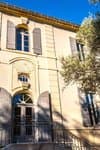
SAINT REMY DE PROVENCE - Cycling from the Alpilles to Val d'Enfer
With this loop you will be quickly rewarded by the beautiful landscape that offer the Val d'Enfer and Baux-de-Provence. In the heart of a calm and soothing environment, you will discover villages and heritage treasures, such as the remains of a Roman aqueduct or Daudet mill.
16 points of interest

Partie de pétanque devant la chapelle Notre-Dame-de-Pitié - ©Rémi Sérange - PNR Alpilles  Patrimony and history
Patrimony and historyThe Notre-Dame de Pitié Chapel
This 14th century chapel was enlarged in 1651 on the vow of the consuls to erect an altar to Saint-Rémy, saint patron of the city, and to Saint-Roch, healer of the plague which ravages Provence then. It is listed on the list of Historic Monuments and today welcomes eleven paintings by Mario Prassinos painter of abstract art. He owned a house in Eygalières and was inspired by the Alpilles for different works.

Canal des Alpines - ©Rémi Sérange - PNR Alpilles  Water and rivers
Water and riversNorthern Alpines Canal
From Orgon, the network of the northern Alpines Canal stretches for 119 km and ends in the Roubines of Anguillon and Vigueirat. Begun in 1826, its construction was slowed by conflicts of interest and ended in 1875. At the time, it was intended to complete the Canal des Alpines meridionales finished in 1772, to supply water to 18 towns and 40 additional mills.

Le Mont Paon et le Mont Valence - ©Rémi Sérange - PNR Alpilles  Panorama
PanoramaView of the south-west of the Alpilles
It is with a superb view on the reliefs of the southwestern part of the Alpilles, that one can distinguish Mont Paon and Mont Valence, both 234 meters high. They are bordered by the Vallon de Cabrieres, and farther west, by the Vallon de la Lèque. They were very early places of privilege for the implantation of human, as evidenced by the various vestiges present on Mount Paon.
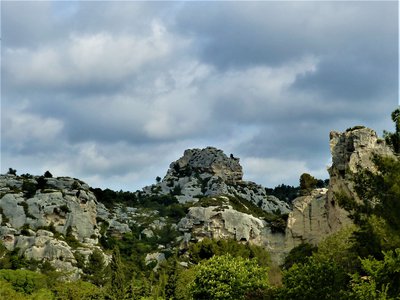
Rochers du Val d'Enfer - ©Rémi Sérange - PNR Alpilles  Geology
GeologyVal d'Enfer
The Val d'Enfer is a valley famous for its rocks with strange shapes, sculpted by erosion. There are also impressive openings in the rock along the road and traces left by limestone quarries. at nightfall, many thought they recognized the rocks and caves of "The Hell" from Dante. Another great writer, who became a filmmaker, Jean Cocteau, shot in 1959, his "Testament of Orpheus” in the natural setting of the Val d'Enfer.

Vue sur les Baux-de-Provence - ©Rémi Sérange - PNR Alpilles  Panorama
PanoramaView of the Baux-de-Provence
An exceptional view of the Baux-de-Provence, labelled "Most Beautiful Villages of France" and located at the top of a rocky outcrop. The Baux-de-Provence are characterized above all by their castle, witness of the power of the family of Les Baux and built in a semi-troglodyte way. This practice involves developing habitats that are partly underground or excavated in the rock, on the side of a massif.

Les Carrières de Lumières - ©Rémi Sérange - PNR Alpilles  Patrimony and history
Patrimony and historyCarrières de Lumières
First known as the Grands Fonts quarry, this stone quarry site ceased operations in 1935. In 1959, the place is reinvested by Jean Cocteau who turns there "The Testament of Orpheus". Then, from 1977, the old quarry was rehabilitated as a cultural center, offering innovative sounds and lights on the rock walls.. This exceptional site, now called "Carrières de Lumières", offers an immersion in the heart of the works of renowned painters.
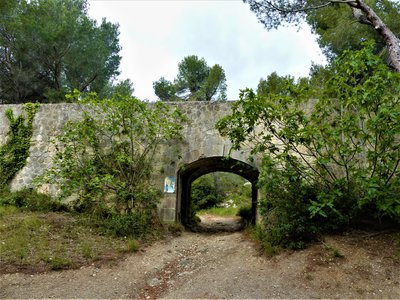
Aqueduc du canal de la vallée des Baux - ©Rémi Sérange - PNR Alpilles  Water and rivers
Water and riversBridge-canal of the Baux valley
In the Alpilles massif, numerous hydraulic structures have been built to supply all municipalities with water. The canal of the Baux valley, put in operation since July 3, 1914, passes along the southern foothills of the massif. The specificity of this environment associated with that of a canal, which must include a gentle slope allowing the good flow of water, led to the development of several canal bridges in the municipalities of Maussane-les-Alpilles and the Paradou.

Centre ville du Paradou - ©Jason Gaydier - PNR Alpilles  Patrimony and history
Patrimony and historyThe village of Paradou
Formerly kniwn as Saint-Martin-de-Castillon, the current name "Paradou" comes, not from "Paradise" although it may seem like one to inhabitants or visitors, but the name of the old water mills of the Arcoule river which enabled weavers to "decorate" the sheets.

Aqueduc de Barbegal - ©Rémi Sérange - PNR Alpilles  Patrimony and history
Patrimony and historyRoman aqueduct of Barbegal
In the 1st century AD, the Romans built two parallel aqueduct bridges, which converged in a basin from which a single conduit leading to Arles. The Barbegal aqueduct was diverted in the 2nd century. AD to feed the Barbegal mill, while the western branch continued to supply the city of Arles. The modified bridge trenched the link of the Pene to feed the mill. The waters were then collected by a channel that evacuated them into marshes.
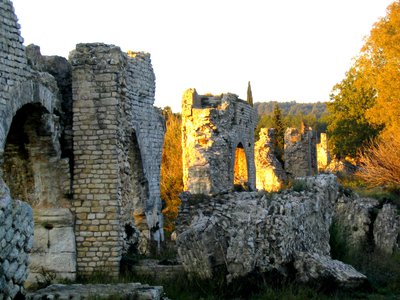
Aqueduc romain de Barbegal - ©PNR Alpilles  Patrimony and history
Patrimony and historyThe Roman aqueduct of Barbegal and the remains of the Roman flour mill
The Roman colony of Arles is endowed itself, around the 1st century AD, with a water supply system using two aqueducts built at the foot of the Alpilles, where you can still find remains today. To the south of the massif, a first aqueduct of about 10km brought water from several springs, collected over Maussane and Paradou. A second aqueduct showing its first remains between Eygalières and Mollégès, went from Fontvieille, where its water mixed with that of the southern aqueduct. The Barbegal flour mill, dated of the 2nd century AD, seems to have worked only a century to supply the population of Arles with wheat.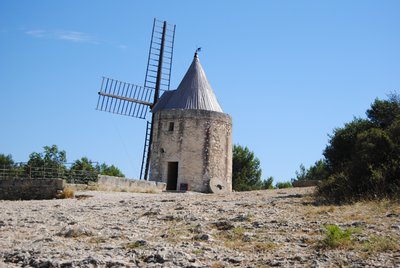
Le moulin d'Alphonse Daudet - ©Chloé Scannapiéco - PNR Camargue  Patrimony and history
Patrimony and historyThe mill of Alphonse Daudet
Between the 18th and early 20th century, Fontvieille lived to the rhythm of the windmills. Built on a rocky promontory, four mills cap the surrounding hills of Fontvieille. Moulin de Daudet, the most recent of the four built mills stopped working in 1914. It was transformed in 1935, paying tribute to the famous writer Alphonse Daudet who portrayed through the tale "Lettres de mon moulin" (Letters from my mill), the consequences of technical changes at that time.
Chapelle Saint-Gabriel - ©Rémi Sérange - PNR Alpilles  Patrimony and history
Patrimony and historySaint-Gabriel Chapel
In the early Middle Ages, a first church was erected instead of an old pagan place of worship. Dedicated to the Archangel Gabriel, it is an important step on the road to Santiago de Compostela. The current chapel was built in the 12th century. and testifies to the splendor of the beginnings of Romanesque art in Provence, as shown by its architecture: its facade, its monumental portal, its carved friezes, or its oculus decorated with symbols of the four evangelists.
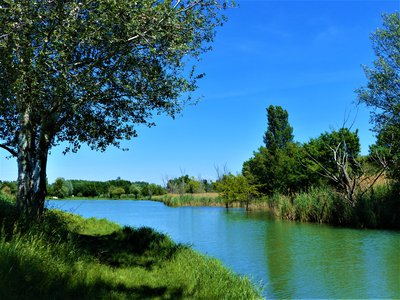
Étang de Rambaille - ©Rémi Sérange - PNR Alpilles  Water and rivers
Water and riversRambaille Pond
The Rambaille pond is one of the few lakes of the Alpilles. Artificial and in which one it is forbidden to swim, it draws its water in the Vigueirat canal and has an area of ??2.5 hectares. It makes the happiness of the fishing lovers from the surroundings. Most white-fleshed fish, as well as pike, trout and zander can be caught.
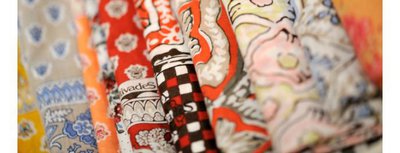
Les Olivades : tradition et innovation textile - ©DR  Savoir-faire
Savoir-faireLes Olivades
Léonard Quinche joined forces in 1818 with two Tarasconnais and created an Indian factory in Saint-Etienne du Grès. In 1948, the company is taken over by Pierre Boudin. In 1977, he created "Les Olivades", a family business that perpetuates the ancestral art of printing on fabric from the south of France, while adapting it to the current life. The Les Olivades brand has been a forerunner in terms of high-end products manufactured and sold by the same company.

Croix annonçant Notre-Dame-du-Château - ©Rémi Sérange - PNR Alpilles  Patrimony and history
Patrimony and historyCross of Notre-Dame-du-Château Chapel
This cross announces the path leading to the Romanesque chapel Notre-Dame-du-Château. This is mentioned for the first time in 1180 and was restored around 1419. Erected on the hill Saint-Michel-de-Briançon, it dominates the village of Saint-Etienne du Grès, former parish of the city of Tarascon. It was a priory chapel dependent on the Abbey Saint-Laurent of Avignon. Since 1350 she welcomed the "Belle Briançonne", a statue of the Virgin to the Child very famous from the Tarasconnais people.

Collégiale Saint-Martin - ©Rémi Sérange - PNR Alpilles  Patrimony and history
Patrimony and historySaint Martin's Collegiate Church
The Saint Martin's Collegiate Church is a catholic church located in Saint-Rémy-de-Provence. Rebuilt in part after a collapse in 1818, it has retained its 14th century Gothic bell tower, but has an imposing entrance with neoclassical columns supporting a triangular pediment. His organ was completely rebuilt by Pascal Quoirin in 1983. The building is also classified as a historical monument since 1984.
Description
From the Inter communal Tourist Office of Saint-Rémy-de-Provence, take the D5 towards the Glanum site to the junction with Joseph d'Arbaud Avenue.
1 - Turn right on the avenue. Continue straight on "Chemin Gaulois" to the irrigation canal. Turn left after the canal, then take the old road on the left to Arles until the intersection with the D27.
2 - Take the D27 left towards Les Baux-de-Provence. Climb the road for 4 km, then go down the Val d'Enfer to Baux-de-Provence.
3 - Continue on the D27 towards Maussane-les-Alpilles to the junction with the D78f. Turn left and continue until the intersection with the D17 in the heart of Maussane-les-Alpilles.
4- Cross the D17 and continue on the way to the pine forest. At the crossroads of the D78c, take it on the right. Continue to the center of Paradou and the intersection with the Belle Croix road.
5 - Turn left on Belle Croix road and continue for about 5 km until you reach the D33.
6 - Turn right towards Fontvieille, until you reach the junction with the D17a. Cross this crossroads and continue towards Saint-Etienne du Grès
7 - (Caution!) At the intersection with the D33a, turn left and continue using the coloured shoulder to the Saint Gabriel chapel.
8 - Just after the chapel, turn right on the D32, always towards Saint-Etienne du Grès. Cross the village, past the town hall.
9 - Before the exit of the village, take on the right the little path of Notre-Dame-du-Château.
10 - After a small bridge, take on the left the path of Calanquet. Continue for 700 m then at the crossroads with the D31, turn right and continue to the center of Saint-Rémy-de-Provence. At the church, turn right to join the departure car park.
- Departure : Inter communal Tourist Office, Saint-Rémy-de-Provence
- Arrival : Saint-Rémy-de-Provence
- Towns crossed : Saint-Rémy-de-Provence, Les Baux-de-Provence, Maussane-les-Alpilles, Paradou, Fontvieille, Tarascon, Saint-Étienne-du-Grès, and Mas-Blanc-des-Alpilles
Forecast
Altimetric profile
Recommandations
Follow the red and white signs marked "Alpilles Val d'Enfer" of Bouches-du-Rhone department.
For your safety, and for the preservation of forest areas, access to natural areas is regulated from June to September. inquire during the summer period on 08 11 20 13 13 (price of a local call) or on www.bouches-du-rhone.pref.gouv.fr download for free the application MYPROVENCE ENVIE DE BALADE (available on Appstore and Android Market)
Information desks
House of the Alpilles Regional Nature Park
2, boulevard Marceau, 13210 Saint-Rémy-de-Provence
Located in the heart of the city centre of Saint-Rémy-de-Provence, the House of the Alpilles Nature Park welcomes you to its completely renovated premises. This new vibrant place is multifunctional: it accommodates the Park's engineering team but also has a public reception space and showrooms. A true resource centre of the Park's heritage, it aims to support and promote locals, visitors and tourists on all 16 municipalities of the Park.
Open Monday to Friday, from 9 am at 12:30 pm and from 1:30 pm to 5 pm.
Free admission.
OTI Alpilles-en-Provence
Place Jean Jaurès, 13210 Saint-Rémy-de-Provence
Transport
.Look for public transport times on the site www.lepilote.com in the town of Saint-Rémy-de-Provence
Access and parking
24 km south of Avignon, by the D571 and the D34
Parking :
Report a problem or an error
If you have found an error on this page or if you have noticed any problems during your hike, please report them to us here:

